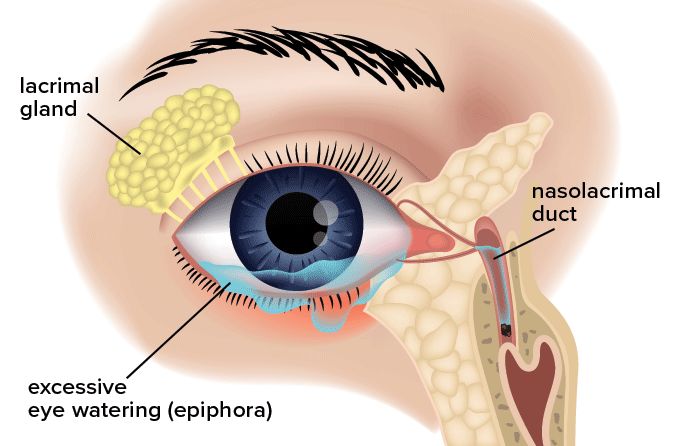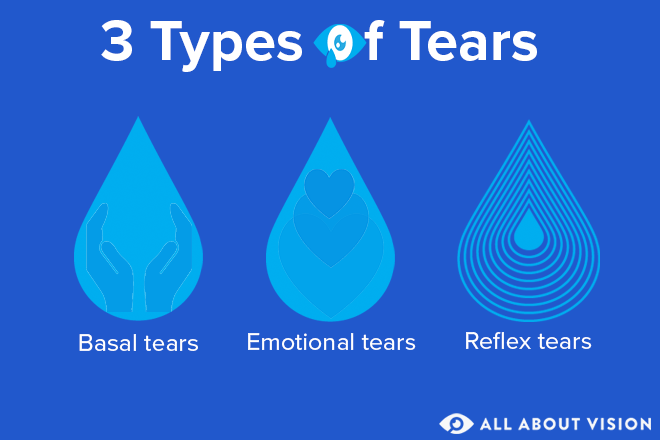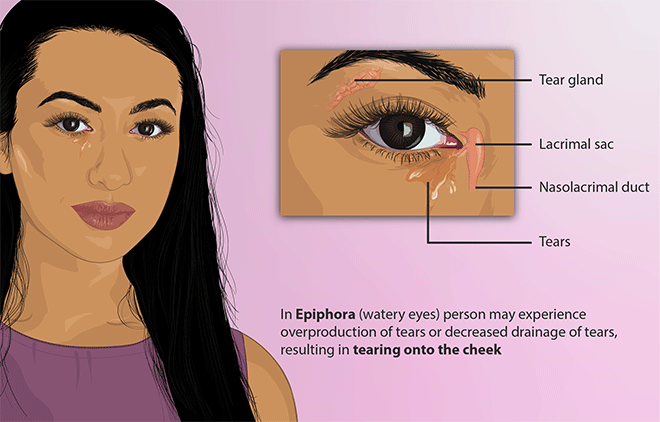Epiphora

What is epiphora?
Epiphora is a condition characterized by excessive eye watering. The condition is fairly common and may affect one or both eyes. Lacrimation, also known as “tear production,” is a natural process performed by the eyes to keep them clean, clear and healthy.
Types of tears
There are different types of tears that provide various functions for the eyes. These include emotional tears, basal tears, reflex tears and crocodile tears (also called hyperlacrimation).
Basal tears are constantly produced by the eyes as a way to clean and protect the cornea. Typically, the eyes produce 1.2 microliters of basal tears per minute — less than one teaspoon per day.

Emotional tears are produced in response to strong — you guessed it — emotions, while reflex tears are produced when the eye is irritated, injured or in pain. Hyperlacrimation is a rare condition in which the facial nerve is injured and, after healing, mistakenly activates the tear gland.
These three types of tears can be produced in large quantities up to one hundred times more than basal tears.
Once tears are produced, they spread over the surface of the eye, which can hold up to eight microliters of tears at any given time. Tears then leave the surface of the eye through small drainage channels in the eyelids called canaliculi at a rate of about 0.6 microliter per minute.
These tears are deposited in the back of the throat. Some of the tears will evaporate from the surface of the eye as well.
A key symptom of epiphora is tears spilling out onto the cheeks. This is because the volume of tears is too much for the eyes’ surface to hold.
Someone with epiphora would produce more than eight microliters of tears at any given time, either by making too many tears or by draining too few tears. Your eye doctor can use different tests to determine which of these two is the cause of epiphora or whether it's a combination of the two.
Babies under 12 months and adults over age 60 are more prone to epiphora. In babies, this is usually caused by a blocked tear duct, while in older adults it can also be from an overproduction of tears.
Minor cases of epiphora may not need medical intervention. However, there are treatments available that can help.
SEE RELATED: What are tears made of?
Symptoms of epiphora

Credit: Depiction of a person with Watery Eyes (Epiphora) by myupchar is licensed under CC BY-SA 4.0.
The main symptom of epiphora is excessive eye watering. Your eyes may feel overly moist, and tears may pool in your eyes, which can blur vision. It’s also possible for tears to spill onto your cheeks, even though you’re not crying.
Causes of excessive eye watering
Epiphora is usually a sign of an underlying problem that’s causing the eyes to water. The following are some potential factors that would lead to watery eyes.
Overproduction of tears
Tears that are triggered by irritants, known as reflex tears, could be causing your eyes to water if there is injury, a scratch or debris in or near the eyes.
Some other causes of tear overproduction include:
Chemical or fume exposure, like that of an onion or chlorine
Irritation caused by dry eye syndrome
Blocked tear drainage
The tear drainage system consists of a small opening in the upper and lower eyelids, close to the nose, called the punctum. The punctum is the opening to a channel called the canaliculus that connects to the tear duct. This is also called the nasolacrimal duct, which runs inside the back of the nose at the inner corner of the eye.
Blockage of the tear drainage system is especially common in babies as their tear ducts have not yet fully developed. If the tear ducts are underdeveloped, they don’t drain tears as easily. So, when a baby cries (which is often) their tears get backed up.
Blocked tear drainage can also occur in older adults. This is because the canaliculi and tear ducts narrow with age. The puncta can also become blocked or point away from the eye.
Without the ability to drain, tears can build up and become stagnant in the tear sac. This can lead to a mild infection, swelling and inflammation if left untreated.
While blocked tear drainage is most common in babies and older adults, it’s very possible for older children and younger adults to experience it. This usually occurs when the tear ducts narrow due to inflammation or swelling in and around the eyes.
Eyelid or eyelash problems
Entropion – Entropion is an age-related condition in which the bottom eyelid folds inward, causing the bottom eyelid and eyelashes to brush against the eye’s surface.
Ectropion – Ectropion is another age-related condition caused by the natural weakening of the muscles surrounding the eye. With ectropion, the bottom eyelids sag downward, away from the eyes’ surface.
Trichiasis – Trichiasis is a condition in which the eyelashes grow inward toward the eye rather than outward. Eyelashes can brush against the eye and cause irritation.
Other problems
If your watery eyes don’t seem to be caused by any of the above-listed conditions, it’s possible that one of the following factors is to blame:
Corneal infection (keratitis)
Use of certain medications, like chemotherapy drugs or epinephrine
SEE RELATED: What will happen if I cry with my contacts in?
Epiphora treatment
The treatment for epiphora depends on the underlying cause. Treatment may not be necessary for mild cases of epiphora, and they usually clear up on their own. If symptoms persist, your eye doctor may suggest treatment based on the following causes:
Different types of eye drops can treat many causes of eye irritation, including allergies, bacterial and allergic conjunctivitis, dry eyes, keratitis, injury and certain cases of corneal ulcer.
Medical procedures can remove foreign objects or debris from the eye. They can also correct symptoms of trichiasis, entropion and ectropion.
Blocked lacrimal drainage system can be treated using several different methods:
Oral medication or medicated eye drops can be prescribed.
Flushing that consists of sending fluid through the tear duct to try and flush out a blockage. This is called dilation and irrigation of the lacrimal drainage system.
Stenting that involves placing a small hollow tube through the puncta, canaliculi and into the tear duct to aid drainage.
Punctoplasty is a procedure in which small incisions are made in the puncta of the eye to create a larger drain opening.
Balloon catheter dilation consists of inserting a small deflated balloon into the tear duct, then inflating the balloon to open the passageway.
Dacryocystorhinostomy is an outpatient procedure that reroutes the path of tear drainage into the back of the nose.
When to see a doctor
Epiphora, while inconvenient, is not a serious condition. However, if you experience any of the following symptoms in addition to having watery eyes, see an eye doctor:
Pain or swelling in or around the eyes
Changes in vision
Consistent eye redness
Pain and watering that occurs first thing in the morning as it may indicate corneal erosion
Foreign body sensation (feeling that something is in your eye)
Talk to your doctor about any issues you’re experiencing with your eyes and/or vision. They can help diagnose and prescribe proper treatment that provides clarity and relief.
READ MORE: Eye discharge: Causes, types and treatment
Watery eyes (epiphora): Causes, treatments, and remedies. Medical News Today. November 2021.
Epiphora. Stat Pearls. May 2022.
The tearing patient: Diagnosis and management. EyeNet Magazine. American Academy of Ophthalmology. June 2009.
Watering eyes (epiphora): Causes and treatment. Patient. November 2017.
Watery eyes. Cleveland Clinic. September 2018.
Watery eyes. Drugs.com. June 2022.
Blocked tear duct (nasolacrimal duct obstruction). Cleveland Clinic. May 2021.
Page published on Thursday, August 25, 2022
Medically reviewed on Monday, August 15, 2022






